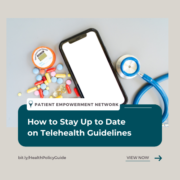How to Stay Up to Date on Telehealth Guidelines
How to Stay Up to Date on Telehealth Guidelines from Patient Empowerment Network on Vimeo.
Joe Kvedar, MD from the American Telemedicine Association shares how patients can stay aware of current telehealth guidelines at their specific health centers and gives insight into how access to telemedicine will be in a post-pandemic society.
See More from the Health Policy Activity Guide
Transcript
Mary Leer:
How can patients find state guidelines about telehealth options? Can I see a Telehealth provider outside of my state?
Joe Kvedar:
In some states, you can. There is something called the Licensure Compact that I think 23 states have signed on to. During the beginning of the pandemic, it was, you could do anything now it’s much less wild, wild west, if I can use that term. So, in certain states, in some states, for instance, the four corner states, Colorado, Utah, and Wyoming, and I forget the forth, they all have a relationship with one another, so that it’s easy for doctors to get licensed in the other states. So, where there’s a lot of rurality and less doctors, these things tend to happen more often, whereas in a place like New York city or Boston, where you have a lot of physicians, there’s less interest in opening it up. So, it’s a complicated answer. I wish we could do better on licensure. I think it’s a very outmoded concept, but there’s so many entrenched interests that want to keep it going, I don’t think any time soon we’re going to see the state licensure paradigm change for physicians.
Mary Leer:
How can patients identify if their health centers have telehealth options?
Joe Kvedar:
Well, these days, everyone, almost everyone does, but everyone has a website, everyone has a patient onboards-man, a patient intake, a patient portal, and any of those resources typically will have…And it used to be prior to the pandemic that you… Those services were often available, but you really had to dig to find them, whereas now it’s pretty much on the front page of again, every hospital website or their portal, or you can call a phone number and get scheduled for someone, it is important for folks to realize that not every problem is suited to telehealth. So, if you ask for a telehealth visit and you get told the doctor would rather see you in person, it may be for a very good reason, it may be that there’s some aspect to that evaluation that really does need to happen in the office. So just to keep that in mind.
Mary Leer:
What will telemedicine look like in a post-pandemic society? That is, is my medical team likely to continue with virtual visits?
Joe Kvedar:
Well, I wish I had a clear answer to that, I can speculate, and a lot of it has to do with this idea of reimbursement. If reimbursement continues to be reasonable from the doctor’s perspective, then you’ll likely see them doing this. And I want to just add that doesn’t mean that doctors are greedy or, but generally people like to get paid for the work that they do. That’s just a general thing. And so, if they have two channels to deliver your service in-person or virtual, and someone says, we can do either, but we’re not going to pay you to do virtual, the chances are they’re going to suggest that you come in for the in-person service. It’s just human nature. And anyway, so I think that’s the big one and how we integrate them. Hospitals are still ambivalent about this, they actually, hospitals do better if you come into the facility for a lot of reasons, so there are a few kinks to work out, but I actually think that the last CMS administrator in the Trump administration, a woman named Seema Verma said it best when she said, “The genie’s out of the bottle and we’re not putting it back.” And I think that’s really how we want to view this; it’s going to happen. We still have a little bit of an uphill battle policy-wise to make it happen, but it will and it’ll be better for our patients as a result.










